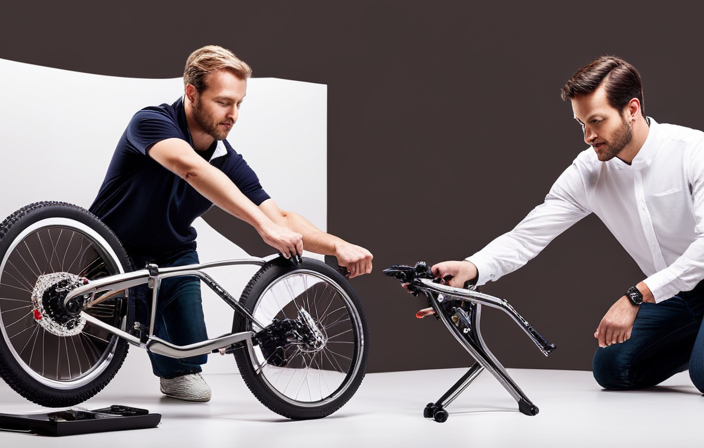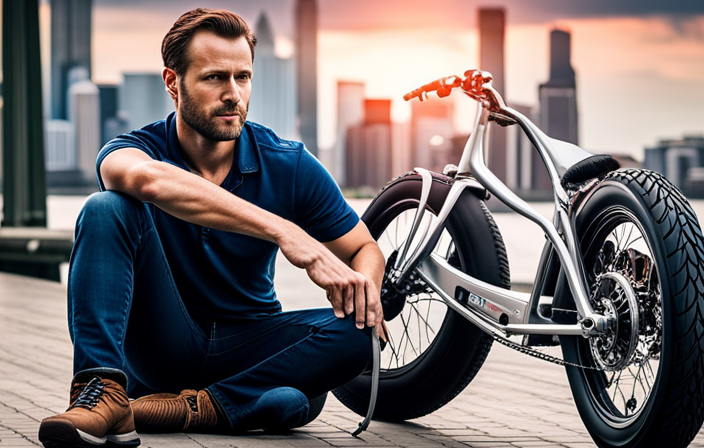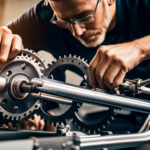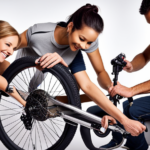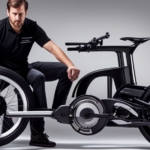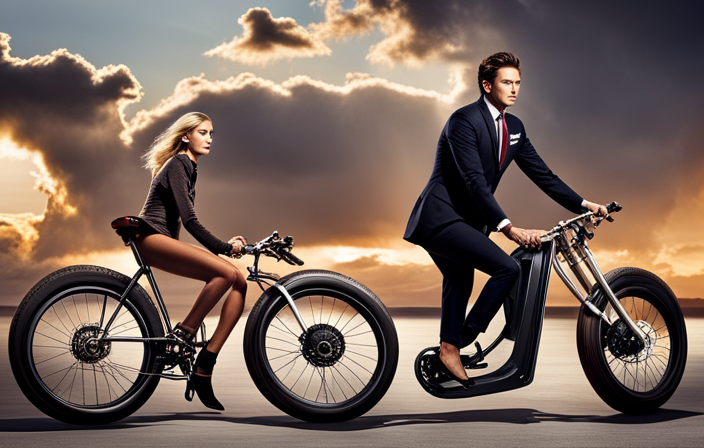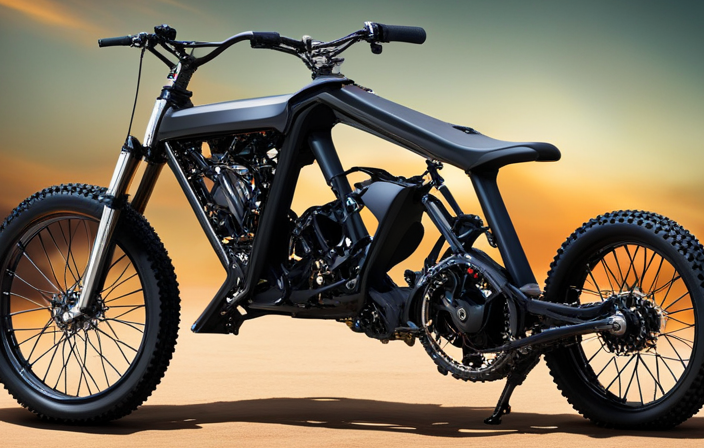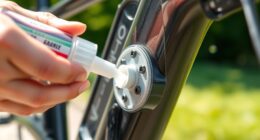Building your own electric bike is like embarking on a thrilling journey, where the destination is a customized ride that perfectly suits your needs and desires.
With the right frame, motor, battery, controller, and a little know-how, you can create a two-wheeled masterpiece that effortlessly combines power and efficiency.
In this article, we will guide you through the step-by-step process of building your electric bike, from selecting the components to ensuring safety and maintenance.
Get ready to unleash your inner engineer and embark on the ride of a lifetime.
Key Takeaways
- Adding a throttle or pedal assist system can enhance the riding experience of your electric bike.
- Mounting the display and control panel is important for easy access and control while riding.
- Customizing your e-bike with accessories can make it more personalized and functional.
- Testing and fine-tuning your electric bike is necessary to ensure optimal performance and safety.
Choosing the Right Frame for Your Electric Bike
When building your electric bike, it’s important to choose the right frame for your specific needs. Choosing the right frame size is crucial to ensuring a comfortable and efficient ride. To determine the correct frame size, you need to consider your height, inseam length, and riding style. A frame that is too small or too big can lead to discomfort and even injury.
Understanding frame materials is another vital aspect. Different materials, such as aluminum, steel, or carbon fiber, have their own unique characteristics in terms of weight, durability, and ride quality. Aluminum frames, for example, are lightweight and affordable, while carbon fiber frames offer superior strength and vibration dampening.
Now that you know how to choose the right frame, let’s move on to selecting the perfect electric motor for your bike.
Selecting the Perfect Electric Motor
To select the perfect electric motor, you should consider factors such as power output and efficiency.
When it comes to electric motor selection for your e-bike, it’s crucial to understand the motor power requirements. The power output of an electric motor is measured in watts, and you need to ensure that the motor you choose can provide enough power to meet your desired speed and acceleration.
Additionally, efficiency is key in order to maximize the range of your electric bike. Look for motors with high efficiency ratings, as this will result in less energy wasted and more miles per charge.
By carefully considering these factors, you can find the perfect electric motor that meets your specific needs.
Now let’s move on to picking the right battery for your e-bike.
Picking the Right Battery for Your E-Bike
Selecting the perfect battery for an e-bike involves considering factors such as capacity and voltage. Battery capacity is a critical factor as it determines how far you can go on a single charge. The higher the capacity, the longer the ride. It is important to calculate your average daily mileage and choose a battery that can meet your needs.
Additionally, battery charging is another important aspect to consider. Look for batteries that have fast charging capabilities, allowing you to quickly get back on the road. Some batteries even have the option for regenerative charging, which can help extend the overall range of your e-bike.
Understanding these aspects of battery selection will ensure that you have the power you need for a smooth and efficient ride.
Moving on to the next section, let’s discuss understanding the different types of controllers.
Understanding the Different Types of Controllers
Understanding the different types of controllers is essential for optimizing the performance of your e-bike. The controller is responsible for regulating the power output from the battery to the electric motor, ensuring smooth and efficient operation. There are three main types of controllers: brushed, brushless, and regenerative.
| Controller Type | Pros | Cons |
|---|---|---|
| Brushed | Simple design, cost-effective | Less efficient, shorter lifespan |
| Brushless | More efficient, longer lifespan | More expensive, complex wiring |
| Regenerative | Recovers energy during braking | Limited availability, higher cost |
To choose the right controller for your e-bike, consider factors such as motor power and battery type. Understanding motor power ensures you select a controller that can handle the required voltage and current. Exploring different battery types helps determine the controller’s compatibility with lithium-ion, lead-acid, or other battery chemistries. Once you have selected the appropriate controller, you can move on to installing the electric motor on your bike, integrating the power source with the main frame.
Installing the Electric Motor on Your Bike
Once the electric motor is properly installed, you can start enjoying the benefits of your e-bike. Here are some electric motor installation tips to ensure a smooth process:
-
Position the motor: Determine the best location for the motor on your bike frame, considering factors like weight distribution and clearance.
-
Secure the motor: Use mounting brackets or clamps to firmly attach the motor to the frame, ensuring it is aligned properly with the chain and sprocket.
-
Connect the motor to the wheel: Install the motor wheel by aligning it with the dropouts and securing it with nuts or quick-release skewers.
-
Test for issues: Before riding, troubleshoot any potential electric motor problems, such as loose connections or abnormal noises.
Once you’ve successfully installed your electric motor, it’s time to move on to the next step of wiring and connecting the electrical components.
Wiring and Connecting the Electrical Components
To wire and connect the electrical components, you’ll need to ensure proper alignment and secure connections for optimal performance. Start by carefully connecting wires from the electric motor to the battery pack, controller, and throttle. Use electrical tape or zip ties to secure the wires in place, making sure they are not tangled or obstructing any moving parts.
Double-check all connections to ensure they are tight and secure. If you encounter any troubleshooting electrical issues, such as a weak power connection or a short circuit, carefully inspect the wiring for any loose or damaged connections. Use a multimeter to test the voltage and continuity of the wires. Remember to follow the manufacturer’s instructions and safety guidelines throughout the process.
Now, let’s move on to choosing the right brakes for your electric bike.
Choosing the Right Brakes for Your Electric Bike
When choosing the right brakes for your e-bike, consider factors such as your riding style, terrain, and desired stopping power. To ensure optimal braking performance, it’s crucial to select the appropriate brake pads for your electric bike.
Look for brake pads specifically designed for e-bikes, as they’re engineered to handle the increased weight and higher speeds associated with electric bicycles. Upgrading to hydraulic brakes can also greatly enhance your riding experience. These brakes utilize fluid pressure to provide superior stopping power and modulation, allowing for precise control over your bike.
Additionally, hydraulic brakes require less maintenance and are less prone to overheating compared to mechanical brakes. Once you have chosen the right brakes, you can proceed to the next step of installing the battery and controller.
Installing the Battery and Controller
Now that you have selected the appropriate brakes, it’s time to install the battery and controller.
First, locate a suitable spot on your electric bike to mount the battery securely. Ensure it is easily accessible and won’t interfere with other components.
Connect the battery to the controller using the provided wiring harness. Make sure all connections are tight and secure.
Once the battery is installed, you can move on to configuring the controller settings. Follow the manufacturer’s instructions to optimize the controller for your specific electric bike. This may involve adjusting parameters such as power output, acceleration, and regenerative braking.
Troubleshooting battery issues is crucial during this process. Ensure the battery is charging properly and monitor its performance to avoid any potential problems.
With the battery and controller successfully installed, you can now proceed to the next step of adding a throttle or pedal assist system to complete your electric bike.
Adding a Throttle or Pedal Assist System
Once you’ve selected the appropriate brakes, it’s time to consider adding a throttle or pedal assist system to your electric bike conversion. This decision will greatly enhance your riding experience and provide several benefits.
Convenience: With a throttle, you can effortlessly control the speed of your electric bike by simply twisting it. This allows for quick acceleration and easy maneuvering.
Comfort: A pedal assist system provides a seamless transition between pedaling and electric power. It amplifies your pedaling efforts, reducing strain on your legs and allowing you to ride longer distances without exhaustion.
Efficiency: The pedal assist system optimizes your battery usage by automatically adjusting the level of electric assistance based on your pedaling speed and force. This ensures maximum efficiency and extends your battery life.
Now that you’ve added the throttle or pedal assist system, it’s time to move on to mounting the display and control panel for your electric bike.
Mounting the Display and Control Panel
To mount the display and control panel, you’ll need to secure it in a visible and easily accessible location. Start by installing the handlebars and grips to create a sturdy base for the display and control panel. Once the handlebars are securely in place, you can attach the display and control panel using the provided mounting brackets. Make sure to position it in a spot where you can easily see and reach it while riding.
Once the display and control panel are mounted, you can begin configuring the display and control settings. This will allow you to customize your e-bike’s performance and functionality to suit your preferences. Use the table below as a guide to understand and adjust the various settings available.
| Setting | Description | Options |
|---|---|---|
| Power Mode | Adjusts the level of assistance provided by the motor | Low, Medium, High |
| Speed Limit | Sets the maximum speed that the motor will assist you up to | 15 mph, 20 mph, 25 mph |
| Trip Meter | Tracks the distance traveled on each trip | On, Off |
| Battery Level | Displays the current battery level | Percentage, Bars |
Once you have completed mounting the display and control panel and configuring the settings, you can move on to customizing your e-bike with accessories, enhancing both its functionality and style.
Customizing Your E-Bike with Accessories
You can personalize your e-bike by adding accessories that enhance its functionality and style. Customizing handlebars allows you to choose a design that best suits your riding preferences and comfort level. You can opt for adjustable handlebars that provide flexibility in positioning or ergonomic grips that reduce hand fatigue during long rides.
Adding lights to your e-bike ensures visibility and safety, especially when riding at night or in low light conditions. Choose from a variety of options, such as front and rear lights, to increase your visibility to other road users.
Additionally, you can install accessories like a phone mount or a water bottle holder to conveniently carry your essentials during rides. By customizing your e-bike with these accessories, you can create a personalized and functional ride.
Moving on to testing and fine-tuning your electric bike, it’s important to ensure its optimal performance.
Testing and Fine-Tuning Your Electric Bike
Testing and fine-tuning an e-bike is crucial to guaranteeing its optimal performance. To ensure that your electric bike is functioning at its best, you need to employ various testing methods.
Begin by testing the battery and motor systems, checking for any issues or malfunctions. Use a multimeter to measure voltage and current readings, ensuring they fall within the manufacturer’s specifications.
Additionally, test the throttle, brakes, and gears for smooth operation. Fine-tuning your e-bike involves adjusting the motor controller settings, such as acceleration and speed limits, to match your preferences. You can also optimize the performance by fine-tuning the pedal-assist level and responsiveness.
Once you have completed the testing and fine-tuning process, you can move on to ensuring safety and compliance with regulations, which is essential for a worry-free riding experience.
Ensuring Safety and Compliance with Regulations
Now that you have tested and fine-tuned your electric bike, it is crucial to ensure rider safety and comply with regulatory requirements.
The safety of the rider should always be the top priority when building an electric bike. This involves installing safety features such as lights, reflectors, and a horn to enhance visibility and alert others.
Additionally, it is important to understand the regulatory requirements in your area regarding electric bikes. This includes knowing the maximum speed limit, age restrictions, and any licensing or registration requirements. Adhering to these regulations not only keeps you safe but also prevents legal issues.
By ensuring rider safety and understanding regulatory requirements, you can confidently and legally ride your electric bike.
In the next section, we will discuss maintaining and troubleshooting your e-bike.
Maintaining and Troubleshooting Your E-Bike
To ensure that your e-bike runs smoothly, it is important to regularly maintain and troubleshoot it. Here are four key steps to help you troubleshoot battery issues and maintain motor performance:
-
Check the battery connections: Ensure that the battery is securely connected to the bike and that the terminals are clean. Loose connections can lead to a loss of power or intermittent performance.
-
Monitor battery health: Regularly check the battery voltage and charge level. If you notice a significant decrease in performance or shorter riding range, it may be time to replace the battery.
-
Clean and lubricate the motor: Keep the motor clean and free from debris. Periodically inspect and lubricate the moving parts to prevent wear and tear.
-
Regularly inspect brakes and tires: Ensure that the brake pads are in good condition and the tires are properly inflated. Faulty brakes or worn-out tires can affect the overall performance and safety of your e-bike.
By properly maintaining and troubleshooting your e-bike, you can enjoy a smooth and reliable ride.
Transitioning into the subsequent section about enjoying the ride: tips for riding and caring for your electric bike, you’ll be able to fully appreciate the benefits of your well-maintained e-bike.
Enjoying the Ride: Tips for Riding and Caring for Your Electric Bike
Get ready to have a blast riding your e-bike and learn some helpful tips for taking care of it along the way.
Riding an electric bike is a unique experience that requires a few specific techniques to ensure a smooth and enjoyable ride. When riding, start by applying gradual pressure to the pedals to engage the motor smoothly. Be mindful of your speed and use the pedal-assist settings accordingly to conserve battery life.
When riding uphill, shift into a lower gear to maintain a steady pace and reduce strain on the motor.
As for maintenance tips, regularly check the tire pressure, brakes, and chain tension to ensure optimal performance. Clean your bike after each ride to remove any dirt or debris, and lubricate the chain regularly to prevent rust and ensure smooth shifting.
Following these riding techniques and maintenance tips will help you fully enjoy your electric bike for years to come.
Frequently Asked Questions
How do I maintain and troubleshoot my electric bike?
To maintain and troubleshoot your electric bike, start by regularly inspecting and cleaning the electric bike battery to ensure optimal performance. Check for any signs of damage or corrosion and replace if necessary.
Additionally, pay attention to the electric bike motor maintenance by lubricating the moving parts and keeping them clean.
If you encounter any issues, consult the manufacturer’s manual or seek professional assistance for a thorough diagnosis and repair.
What are some safety regulations I should be aware of when riding my electric bike?
When riding your electric bike, it’s crucial to be aware of safety regulations.
Always wear a helmet and use proper lighting, reflective gear, and signaling devices.
Follow traffic laws, yield to pedestrians, and stay in designated bike lanes when available.
Regularly check your brakes, tires, and battery to avoid common electric bike problems.
Maintain a safe speed and be cautious when turning or changing lanes.
Remember, your safety and the safety of others is paramount.
Can you give me some tips for riding and caring for my electric bike?
When it comes to riding and caring for your electric bike, there are a few essential tips to keep in mind.
First, invest in high-quality electric bike accessories like a helmet, lights, and a lock to ensure your safety and the security of your bike.
Second, consider different electric bike storage options such as wall-mounted racks or floor stands to keep your bike protected and organized.
Following these tips will help you enjoy a smooth and worry-free ride.
What are some frequently encountered issues with electric bikes and how can I fix them?
When it comes to common electric bike problems, there are a few issues you may encounter.
One frequent problem is a malfunctioning battery, which can be resolved by checking the connections and ensuring it is fully charged.
Another issue is a faulty motor, which may require professional repair.
Additionally, problems with the throttle or controller can be fixed by inspecting the wiring and connections.
It is crucial to regularly maintain and inspect your electric bike to prevent and troubleshoot any issues that may arise.
Are there any specific maintenance tasks I need to perform regularly on my electric bike?
To ensure optimal performance and longevity of your electric bike, regular maintenance tasks are crucial.
Start by inspecting the battery and connections for any signs of damage or corrosion.
Clean and lubricate the chain regularly to prevent wear and noise.
Check the brakes for proper alignment and adjust if necessary.
Lastly, examine the tires for wear and inflate them to the recommended pressure.
Following these steps will help prevent common issues and keep your electric bike running smoothly.
Conclusion
So there you have it, fellow rider. You’ve reached the end of this journey, and now you possess the knowledge to build your very own electric bike.
With the right frame, motor, battery, and controller, you’ll create a masterpiece that glides through the streets with ease.
But remember, safety and compliance are key, so don’t forget to maintain and troubleshoot your e-bike regularly.
And as you embark on your electric adventure, always care for your two-wheeled companion like a gentle breeze caressing your face, and enjoy the exhilarating ride it brings.
